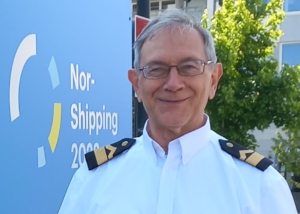Nuclear reactors for ships



 By Marek Grzybowski
By Marek Grzybowski
At the end of July The English nuclear technology company “newcleo”, the Fincantieri shipbuilding group and the classification society RINA have signed a historic agreement. They plan to implement safe nuclear technology for sea transport using innovative generation IV reactors.
Nuclear reactors have already been used on the vessels to power icebreakers and merchant ships. The N.S. Savannah was the world’s first nuclear powered merchant ship. It launched in 1959 as part of the Atoms for Peace program.The icebreaker Lenin was the world’s first nuclear-powered surface vessel (20,000 dwt), commissioned in 1959.
SMR – New Level of Solutions
However, we are entering a new level of solutions, because “newcleo” proposes systems that use nuclear waste as fuel for the propulsion system. Before the solution is installed on the ship, conceptual work will be carried out.
The companies announce that they will combine “their extensive international expertise and innovation experience to jointly conduct a feasibility study of nuclear systems applications in maritime transport, including “newcleo’s small modular refrigerated reactor (SMR)” technology.
Shipbuilders from the Republic of Korea are moving in a similar direction. Nine South Korean organizations have signed a memorandum of cooperation in the development and construction of ships and offshore systems powered by small modular reactors (SMRs). The partners to the agreement also committed to develop systems and hydrogen production using MSR reactors.
Korean MSR to ship
The Koreans will develop a reactor large enough to be mounted on a ship. They argue that with the MSR, there will be no need to change the nuclear fuel during the life of the ship. However, when the reactor malfunctions, it will be designed so that molten salt – which is liquid nuclear fuel – will harden.
This will prevent serious failures. The compact design of the MSR facilitates space for large spaces on the ship for cargo. Unlike diesel engines, it is also an ecological source of energy that does not emit carbon dioxide, emphasize the members of the agreement.
The project involves H-Line Shipping, Hyundai Merchant Marine (HMM), Janggeum Merchant Marine (Sinokor) and Wooyang Merchant Marine as well as the Korea Atomic Energy Research Institute (KAERI), Korea Register of Shipping and the Korea Ship & Offshore Plant Research Institute ( KRISO).
LFR on an Italian navy ship
The Italians emphasize that the implementation of the innovative LFR (Liquid Fluoride Thorium Reactor) by “newcleo” to propel the ship would involve placing a closed mini reactor on the ships as a small generator providing 30 MW of electric power. This would only require refueling once every 10-15 years. The maintenance of such a reactor and the power supply system requires little maintenance.
“I am pleased that with this important feasibility study we are launching a civil nuclear propulsion project for the navy,” underlined Stefano Buono, President and CEO of “newcleo” after signing the cooperation agreement. It is also easy to replace the system or fuel at the end of its life.
According to the English producers and the Italian partners, “Using clean nuclear energy to power seagoing ships would help to rapidly decarbonise a sector that is struggling with huge fossil fuel consumption and consequent carbon emissions.”
– From the beginning, newcleo’s ambition has been to contribute to accelerating decarbonisation and providing clean, sustainable and affordable energy to meet the needs of communities and businesses. the results of the feasibility study and the next stages of the project – said Buono.
“Today, Fincantieri reaffirms its vocation to pioneer progress in the maritime sector by [introducing into ship design – MG] cutting-edge, efficient and sustainable technologies,” said Pierroberto Folgiero, CEO of Fincantieri.
Nuclear propulsion better than methanol
Professor Jan Emblemsvåg from the Norwegian University of Science and Technology urged the use of small nuclear reactors to propel ships at the summer Gard seminar “Making Waves – geopolitics, energy and the future of shipping”, which took place in mid-2015. informs Gard.no.
In his opinion, green ammonia is neither the best nor the prospective solution. Although it is promoted as the best solution in the process of decarbonizing maritime transport, and is especially recommended for operators of large ships. In his opinion, a significant problem is the energy density obtained from this fuel and the need for large tanks for its storage to ensure that long oceanic routes are covered.
– In 2020, about 580 large container ships sailed the seas, using an average of 250 – 350 t of HFO per day. This corresponds to an average energy demand of 3,350 MWh per day, as a ton of HFO has a calorific value of 11.2 MWh/ton. Ammonia has a calorific value of 5.2 MWh/ton, such a ship requires about twice as much ammonia tanks in terms of volume than for HFO, quotes Professor Jan Emblemsvåg Gard.no.
Nuclear propulsion of the ship and sails
In Great Britain, they did not stop at theoretical considerations but went even further. They intend to combine nuclear propulsion with sails. The British company Nuclear Transport Solutions (NTS), which is part of the Nuclear Decommissioning Authority (NDA), cooperates with Smart Green Shipping (SGS) specialists who have experience in the field of renewable marine technologies.
As part of the joint project, it is planned to explore the possibilities of using the new technology of rigid sails together with nuclear power plants to propel ships. SGS develops unique FastRig retrofit sails and sustainable technology for commercial vessels.
As you can see from this short overview of different approaches to the use of small reactors in ship propulsion, even before the innovative dual-fuel and even tri-fuel engines were seriously implemented, ships with small nuclear reactors were on the boards of designers.
The use of nuclear waste to power SMRs sounds promising. And since the efforts to use small reactors are carried out on different continents, an interesting race for innovative solutions is about to take place.
